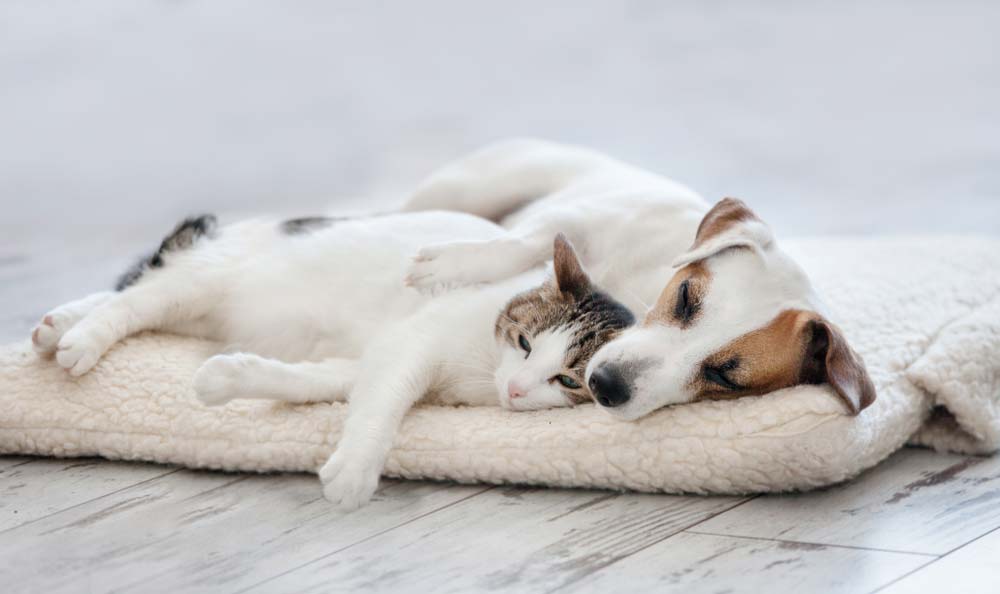Picture this. You work in an open-plan office, but you simply don’t get along with the person in the desk alongside yours. Or someone in the office insists on wearing perfume that gives you a headache. Once you leave that office environment and go home, it’s fine, but the tension starts up again the next day when you are back at work.
Now consider this same scenario with regard to your pets. If you have dogs and decide to bring a cat home, you can’t simply plonk the cat down and let the pets work it out. They could be fearful of one another and even show signs of overt aggression. And there’s no escape like in the office scenario!
It takes forethought to introduce a cat to a doggie-dominated household. Follow a strict game plan to ensure that pets will accept one another and, ideally, become firm friends.
Understanding Your Dogs
You may adore cats but your dogs may have other ideas about feline intrusion. It’s important to understand the characteristics and innate traits of your dog(s). Some dogs have a strong prey drive. It may be impossible to introduce a cat to the household if your dog is already an adult and set in her ways. Be realistic.
Has your dog ever seen a cat before? How does she react?
If in doubt, don’t adopt a cat. This avoids having to rehome a cat or take her back to the shelter.
If you are confident enough to proceed, never choose a new family member simply because you think he or she looks cute. All animals have the irresistible cute-factor! Personality traits that gel between species are the key to success.
Personality-Matching Pets
This means doing homework and being knowledgeable about and accepting of your pooch. Mixed breeds can be a challenge, especially when your lovable mutt has a diverse parentage! Having your dog’s DNA analyzed via a home test kit may be beneficial in understanding the breed traits that contribute to her personality. It’s also worth having a discussion with your veterinarian, who knows and understands your dog and may be able to give some insight into how your dog may react.
Apart from personality traits, take into account your dog’s age. Here again, a veterinarian can offer sound advice as to whether to adopt a kitten or an adult cat.
Similarly, bringing the right cat into the mix is important. Do your feline homework.
For example, orange tabbies, tortoiseshell-patterned felines, and calicos are known for their “big personalities.” They may be more willing to stand up for themselves or challenge your dog. Those traits may or may not be the best fit with your canine family, depending on whether they are outgoing or sensitive or timid.
If possible, adopt a cat who has previously lived in a multipet household or was previously fostered in a household with dogs. Learn as much as you can about the cat’s personality. Don’t be shy about asking the shelter or foster family for any available background information. Some cats are surprisingly mellow and laid back.
Getting to Know You
Introductions are crucial. Behavior experts suggest that new pet housemates meet by smell first.
Sequester your new cat in one room. Rub her and the incumbent dog(s) with socks and then swap them out to set up an olfactory introduction to one another.
Then confine the dog with a puzzle feeder to distract her and let the cat explore the dog’s territory. After that, confine the cat with a fun toy and let the dog sniff around where she’s been.
Closely supervise face-to-face meetings. Have the dog on leash so you can gently redirect her if needed. Never leave your menagerie alone until you are sure they are comfortable with one another. The cat should have an escape route that allows her to go up (a cat tree, for instance), under, or inside an object where she can be safe and that will offer privacy from the dogs.
Other Useful Tips
Brush all pets in the household with the same brush to mingle their scents.
Use pheromone plug-ins that replicate both cat and dog pheromones. Place them around the home to ease any anxiety and fearfulness.
If you have concerns, ask a Fear Free veterinarian or a qualified animal behaviorist for advice.
Be patient. It can take a week to several months for relationships to develop, but when you see them all getting along and even playing together, it is well worth it!
This article was reviewed/edited by board-certified veterinary behaviorist Dr. Kenneth Martin and/or veterinary technician specialist in behavior Debbie Martin, LVT.








